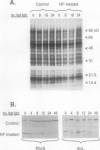Abstract
The effects of high light stress on chloroplast ultrastructure and protein and mRNA composition were investigated in carotenoid-deficient peas (Pisum sativum, L.). In low light, the thylakoid membrane polypeptide pattern was altered, with several prominent chlorophyll-binding proteins present in diminished amounts. This change was found to be reflected in the ultrastructural organization of internal chloroplast membranes. In contrast to the normal grana stacking found in the controls, carotenoid-deficient plastids contained long, unstacked lamellae. Exposure to photooxidative light that resulted in destruction of >70% of chlorophyll did not lead to changes in total RNA and total cellular protein patterns. This treatment did lead to gross alterations in the chloroplast structure. Within 24 hours the plastid was seen as a swollen vesicle with only a few membrane remnants still present. Accumulation of five plastid-encoded mRNAs encoding a diverse array of photosynthetic proteins was found to be affected in different ways. While psaA mRNA was rapidly reduced by more than 75%, levels of psbF/E and atpB/E were reduced by 50%. psbA and petA mRNAs, on the other hand, appeared to be more resistant to photobleaching and remained relatively unchanged during 24 hours of high fluence-rate light treatment.
Full text
PDF







Images in this article
Selected References
These references are in PubMed. This may not be the complete list of references from this article.
- Bachmann M. D., Robertson D. S., Bowen C. C., Anderson I. C. Chloroplast development in pigment deficient mutants of maize. I. Structural anomalies in plastids of allelic mutants at the w3 locus. J Ultrastruct Res. 1967 Nov;21(1):41–60. doi: 10.1016/s0022-5320(67)80005-4. [DOI] [PubMed] [Google Scholar]
- Bachmann M. D., Robertson D. S., Bowen C. C., Anderson I. C. Chloroplast ultrastructure in pigment-deficient mutants of Zea mays under reduced light. J Ultrastruct Res. 1973 Dec;45(5):384–406. doi: 10.1016/s0022-5320(73)80069-3. [DOI] [PubMed] [Google Scholar]
- Bartels P. G., Hyde A. Chloroplast Development in 4-Chloro-5-(dimethylamino)-2-(alpha,alpha,alpha-trifluoro-m-tolyl)-3 (2H)-pyridazinone (Sandoz 6706)-treated Wheat Seedlings: A Pigment, Ultrastructural, and Ultracentrifugal Study. Plant Physiol. 1970 Jun;45(6):807–810. doi: 10.1104/pp.45.6.807. [DOI] [PMC free article] [PubMed] [Google Scholar]
- Bartels P. G., McCullough C. A new inhibitor of carotenoid synthesis in higher plants: 4-chloro-5-(dimethylamino)-2- , , ,(trifluoro-m-tolyl)-3(2H)-pyridazinone. Biochem Biophys Res Commun. 1972 Jul 11;48(1):16–22. doi: 10.1016/0006-291x(72)90337-3. [DOI] [PubMed] [Google Scholar]
- Batschauer A., Mösinger E., Kreuz K., Dörr I., Apel K. The implication of a plastid-derived factor in the transcriptional control of nuclear genes encoding the light-harvesting chlorophyll a/b protein. Eur J Biochem. 1986 Feb 3;154(3):625–634. doi: 10.1111/j.1432-1033.1986.tb09444.x. [DOI] [PubMed] [Google Scholar]
- Ben-Aziz A., Koren E. Interference in Carotenogenesis as a Mechanism of Action of the Pyridazinone Herbicide Sandoz 6706: Accumulation of C-40 Carotenoid Precursors Inhibition of beta-Carotene Synthesis and Enhancement of Phytoene Epoxidation. Plant Physiol. 1974 Dec;54(6):916–920. doi: 10.1104/pp.54.6.916. [DOI] [PMC free article] [PubMed] [Google Scholar]
- Blume D. E., McClure J. W. Developmental Effects of Sandoz 6706 on Activities of Enzymes of Phenolic and General Metabolism in Barley Shoots Grown in the Dark or under Low or High Intensity Light. Plant Physiol. 1980 Feb;65(2):238–244. doi: 10.1104/pp.65.2.238. [DOI] [PMC free article] [PubMed] [Google Scholar]
- Bradford M. M. A rapid and sensitive method for the quantitation of microgram quantities of protein utilizing the principle of protein-dye binding. Anal Biochem. 1976 May 7;72:248–254. doi: 10.1016/0003-2697(76)90527-3. [DOI] [PubMed] [Google Scholar]
- Deng X. W., Gruissem W. Constitutive transcription and regulation of gene expression in non-photosynthetic plastids of higher plants. EMBO J. 1988 Nov;7(11):3301–3308. doi: 10.1002/j.1460-2075.1988.tb03200.x. [DOI] [PMC free article] [PubMed] [Google Scholar]
- Deng X. W., Gruissem W. Control of plastid gene expression during development: the limited role of transcriptional regulation. Cell. 1987 May 8;49(3):379–387. doi: 10.1016/0092-8674(87)90290-x. [DOI] [PubMed] [Google Scholar]
- Feierabend J., Schubert B. Comparative Investigation of the Action of Several Chlorosis-inducing Herbicides on the Biogenesis of Chloroplasts and Leaf Microbodies. Plant Physiol. 1978 Jun;61(6):1017–1022. doi: 10.1104/pp.61.6.1017. [DOI] [PMC free article] [PubMed] [Google Scholar]
- Feierabend J., Winkelhüsener T. Nature of photooxidative events in leaves treated with chlorosis-inducing herbicides. Plant Physiol. 1982 Nov;70(5):1277–1282. doi: 10.1104/pp.70.5.1277. [DOI] [PMC free article] [PubMed] [Google Scholar]
- Gorton H. L., Briggs W. R. Phytochrome Responses to End-of-Day Irradiations in Light-grown Corn Grown in the Presence and Absence of Sandoz 9789. Plant Physiol. 1980 Dec;66(6):1024–1026. doi: 10.1104/pp.66.6.1024. [DOI] [PMC free article] [PubMed] [Google Scholar]
- Jabben M., Deitzer G. F. Effects of the herbicide san 9789 on photomorphogenic responses. Plant Physiol. 1979 Mar;63(3):481–485. doi: 10.1104/pp.63.3.481. [DOI] [PMC free article] [PubMed] [Google Scholar]
- Kyle D. J., Ohad I., Arntzen C. J. Membrane protein damage and repair: Selective loss of a quinone-protein function in chloroplast membranes. Proc Natl Acad Sci U S A. 1984 Jul;81(13):4070–4074. doi: 10.1073/pnas.81.13.4070. [DOI] [PMC free article] [PubMed] [Google Scholar]
- Mayfield S. P., Nelson T., Taylor W. C. The Fate of Chloroplast Proteins during Photooxidation in Carotenoid-Deficient Maize Leaves. Plant Physiol. 1986 Nov;82(3):760–764. doi: 10.1104/pp.82.3.760. [DOI] [PMC free article] [PubMed] [Google Scholar]
- Moran R. Formulae for determination of chlorophyllous pigments extracted with n,n-dimethylformamide. Plant Physiol. 1982 Jun;69(6):1376–1381. doi: 10.1104/pp.69.6.1376. [DOI] [PMC free article] [PubMed] [Google Scholar]
- Peterson G. L. A simplification of the protein assay method of Lowry et al. which is more generally applicable. Anal Biochem. 1977 Dec;83(2):346–356. doi: 10.1016/0003-2697(77)90043-4. [DOI] [PubMed] [Google Scholar]
- Sagar A. D., Briggs W. R., Thompson W. F. Nuclear-Cytoplasmic Partitioning of Phytochrome-Regulated Transcripts in Pisum sativum. Plant Physiol. 1988 Dec;88(4):1397–1402. doi: 10.1104/pp.88.4.1397. [DOI] [PMC free article] [PubMed] [Google Scholar]
- Sagar A. D., Horwitz B. A., Elliott R. C., Thompson W. F., Briggs W. R. Light effects on several chloroplast components in norflurazon-treated pea seedlings. Plant Physiol. 1988 Oct;88(2):340–347. doi: 10.1104/pp.88.2.340. [DOI] [PMC free article] [PubMed] [Google Scholar]
- Troxler R. F., Lester R., Craft F. O., Albright J. T. Plastid development in albescent maize. Plant Physiol. 1969 Nov;44(11):1609–1618. doi: 10.1104/pp.44.11.1609. [DOI] [PMC free article] [PubMed] [Google Scholar]






